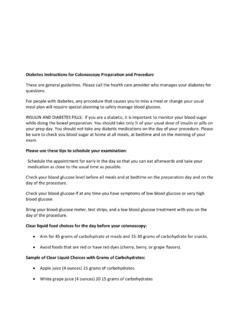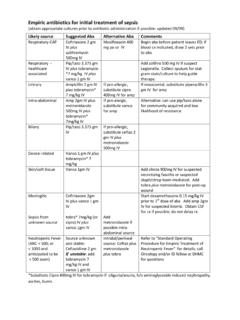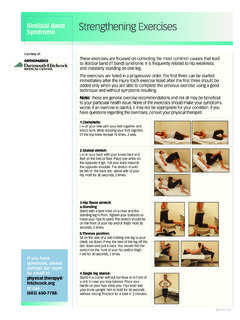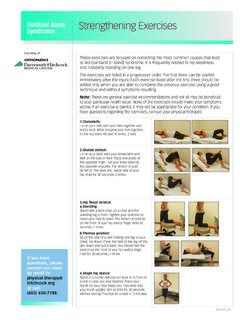Transcription of Dynamic Gait Index - Dartmouth-Hitchcock
1 Page 1 of 2 Dynamic gait IndexDescription:Developed to assess the likelihood of falling in older adults. Designed to test eight facets of needed: Box (Shoebox), Cones (2), Stairs, 20 walkway, 15 wideCompletion:Time:15 minutesScoring:A four-point ordinal scale, ranging from 0-3. 0 indicates the lowest level offunction and 3 the highest level of Score = 24 Interpretation:< 19/24 = predictive of falls in the elderly> 22/24 = safe ambulators1. gait level surface _____Instructions: Walk at your normal speed from here to the next mark (20 )Grading: Mark the lowest category that applies.
2 (3) Normal: Walks 20 , no assistive devices, good sped, no evidence for imbalance, normal gait pattern(2) Mild Impairment: Walks 20 , uses assistive devices, slower speed, mild gait deviations.(1)Moderate Impairment: Walks 20 , slow speed, abnormal gait pattern, evidence for imbalance.(0)Severe Impairment: Cannot walk 20 without assistance, severe gait deviations or Change in gait speed _____Instructions: Begin walking at your normal pace (for 5 ), when I tell you go, walk as fast as you can (for5 ). When I tell you slow, walk as slowly as you can (for 5 ).Grading: Mark the lowest category that applies.
3 (3) Normal: Able to smoothly change walking speed without loss of balance or gait deviation. Shows asignificant difference in walking speeds between normal, fast and slow speeds.(2) Mild Impairment: Is able to change speed but demonstrates mild gait deviations, or not gaitdeviations but unable to achieve a significant change in velocity, or uses an assistive device.(1)Moderate Impairment: Makes only minor adjustments to walking speed, or accomplishes a changein speed with significant gait deviations, or changes speed but has significant gait deviations, orchanges speed but loses balance but is able to recover and continue walking.
4 (0)Severe Impairment: Cannot change speeds, or loses balance and has to reach for wall or be gait with horizontal head turns _____Instructions: Begin walking at your normal pace. When I tell you to look right, keep walking straight, butturn your head to the right. Keep looking to the right until I tell you, look left, then keep walking straightand turn your head to the left. Keep your head to the left until I tell you look straight, then keep walkingstraight, but return your head to the : Mark the lowest category that applies.(3) Normal: Performs head turns smoothly with no change in gait .
5 (2) Mild Impairment: Performs head turns smoothly with slight change in gait velocity, , minordisruption to smooth gait path or uses walking aid.(1)Moderate Impairment: Performs head turns with moderate change in gait velocity, slows down,staggers but recovers, can continue to walk.(0)Severe Impairment: Performs task with severe disruption of gait , , staggers outside 15 path, loses balance, stops, reaches for 2 of 24. gait with vertical head turns _____Instructions: Begin walking at your normal pace. When I tell you to look up, keep walking straight, but tipyour head up.
6 Keep looking up until I tell you, look down, then keep walking straight and tip your headdown. Keep your head down until I tell you look straight, then keep walking straight, but return your headto the : Mark the lowest category that applies.(3) Normal: Performs head turns smoothly with no change in gait .(2)Mild Impairment: Performs head turns smoothly with slight change in gait velocity, , minordisruption to smooth gait path or uses walking aid.(1)Moderate Impairment: Performs head turns with moderate change in gait velocity, slows down,staggers but recovers, can continue to walk.
7 (0) Severe Impairment: Performs task with severe disruption of gait , , staggers outside 15 path, loses balance, stops, reaches for gait and pivot turn _____Instructions: Begin walking at your normal pace. When I tell you, turn and stop, turn as quickly as you canto face the opposite direction and : Mark the lowest category that applies.(3) Normal: Pivot turns safely within 3 seconds and stops quickly with no loss of balance.(2) Mild Impairment: Pivot turns safely in > 3 seconds and stops with no loss of balance.(1)Moderate Impairment: Turns slowly, requires verbal cueing, requires several small steps to catchbalance following turn and stop.
8 (0)Severe Impairment: Cannot turn safely, requires assistance to turn and Step over obstacle ____Instructions: Begin walking at your normal speed. When you come to the shoebox, step over it, not around it,and keep : Mark the lowest category that applies.(3) Normal: Is able to step over the box without changing gait speed, no evidence of imbalance.(2)Mild Impairment: Is able to step over box, but must slow down and adjust steps to clear box safely.(1)Moderate Impairment: Is able to step over box but must stop, then step over. May require verbalcueing.(0)Severe Impairment: Cannot perform without Step around obstacles _____Instructions: Begin walking at normal speed.
9 When you come to the first cone (about 6 away), walk aroundthe right side of it. When you come to the second cone (6 past first cone), walk around it to the : Mark the lowest category that applies.(3)Normal: Is able to walk around cones safely without changing gait speed; no evidence ofimbalance.(2)Mild Impairment: Is able to step around both cones, but must slow down and adjust steps to clearcones.(1)Moderate Impairment: Is able to clear cones but must significantly slow, speed to accomplish task,or requires verbal cueing.(0)Severe Impairment: Unable to clear cones, walks into one or both cones, or requires Steps _____Instructions: Walk up these stairs as you would at home, , using the railing if necessary.
10 At the top, turnaround and walk : Mark the lowest category that applies.(3) Normal: Alternating feet, no rail.(2) Mild Impairment: Alternating feet, must use rail.(1)Moderate Impairment: Two feet to a stair, must use rail.(0) Severe Impairment: Cannot do SCORE: ___ / 24 References:1. Herdman SJ. Vestibular Rehabilitation. 2nd ed. Philadelphia, PA: Co; Shumway-Cook A, Woollacott M. Motor Control Theory and Applications, Williams and Wilkins Baltimore, 1995: 323-324







